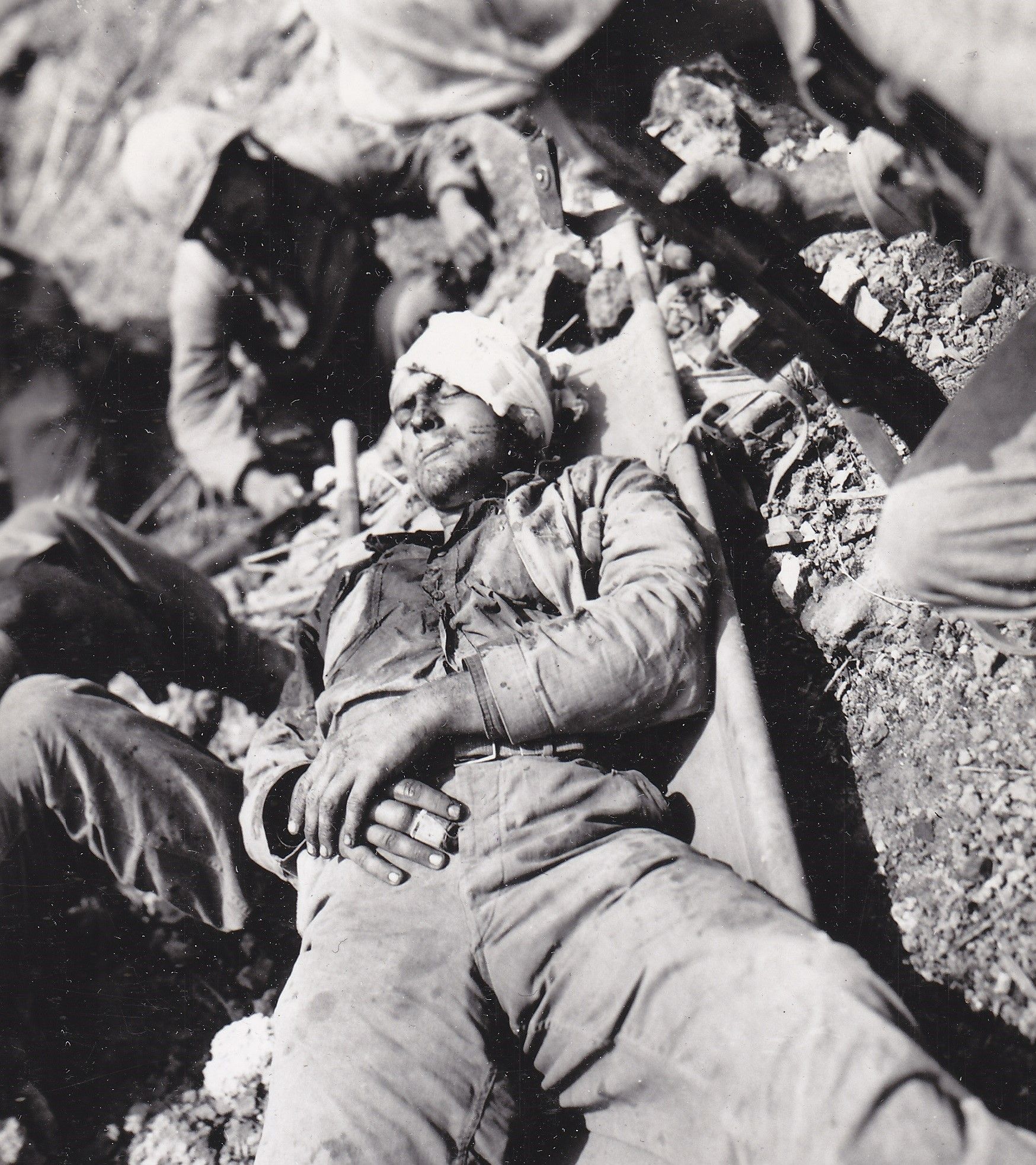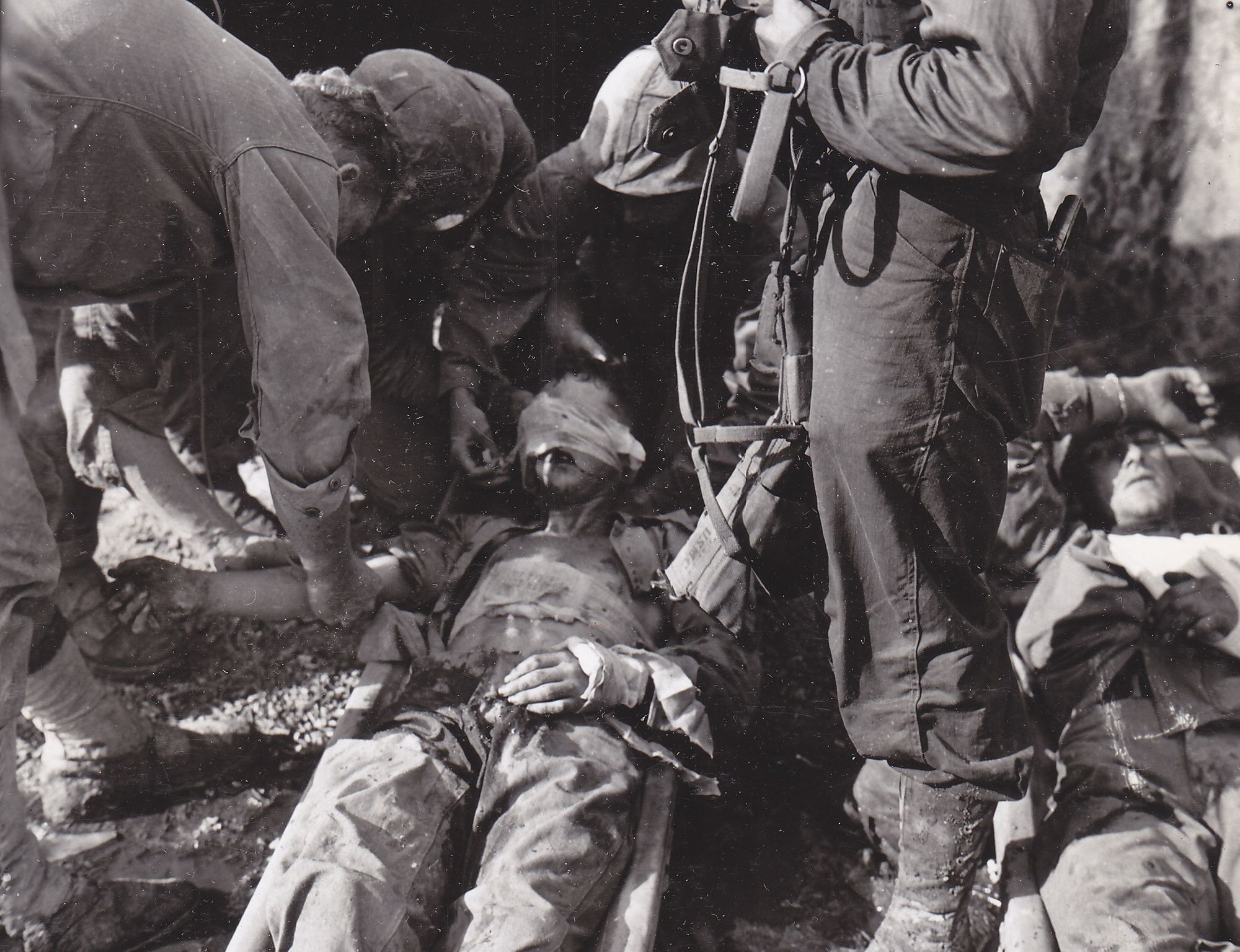"War is a gluttonous and capricious feeder. It demands the full strength of men for its food. But so vicious and profligate are its habits that many who approach it as sacrifices are merely mauled, bled, and thrown aside half devoured."
When Keith Wheeler landed on Iwo Jima he was already familiar with the experience of combat. For years he had been covering the Pacific war as a correspondent for the Chicago Times, but the savagery of the fighting on Iwo Jima appalled him. Moving off the beach he recalled, "There were many dead. I thought I had never seen so many dead at the edge of a beach except possibly at Tarawa." [1]
On the second day of the battle he was shot in the neck while observing Marines advancing:
A violence nothing had ever taught me to believe possible smashed against the right side of my face. I was falling and as I fell a hot red freshet sprouted before my eyes.
I was hit. That unbelievably savage but painless blow that couldn't have been anything else. . . It was a bad hit. I knew that, knew where it was. All that blood. . . So that was it. I was killed. [2]
Saved by quick-acting corpsmen and evacuated for further treatment, Wheeler's survival was almost miraculous.

It would take Wheeler months to recover from his wounds. The majority of his treatment occurred in the sprawling Naval hospital in Aiea Heights, Hawaii, near Pearl Harbor. At Aiea, Wheeler was at first uncomfortable and embarrassed to be in the same hospital with men who had lost limbs, "I felt I had no right to confront them with my sound body" but that quickly dissipated when he spoke to some of them and noted that "they were swelled with such a bounteous load of gratitude at being alive at all that no room remained in them to harbor envy or resentment". [3] He could not believe how cheerful many of the wounded men were, joking and laughing about their injuries:
The capacity of wounded men to accept the loss of useful parts and functions of the body instantly, and without regret or recrimination, never failed to amaze and humble me, no matter how often it was demonstrated. I simply couldn't place myself in those shattered bodies and see how I could accept the future to which they were condemned. [4]
But We are the Wounded is not a superficial or propagandized story of American servicemen who thoughtlessly and without complaint offered their bodies to their country. Wheeler's writing reveals the men recovering at Aiea as individuals, each with their own feelings, fears, and aspirations in ways that few other writers have ever been able. In We are the Wounded, Wheeler presents the casualties, typically marginalized in the telling of military history beyond their statistical relevance, not as an impersonal entity but dynamic individuals.
The following, from the chapter titled "The Faceless" is particularly poignant:
Most of the time he lay with a sheet over what was left of his head. There was another kid in the quiet room with him. They'd been buddies a long time and were together on Iwo when they were hit. The second kid had drawn a minor flesh wound. By luck they had been evacuated together and had been assigned together at a forward hospital.
It was there the surgeons noticed that the slightly hurt youngster cared for the other one constantly, fed him, washed him, and helped him to the head, waited on him like a mother.
The slightly hurt one was so good for the other that the doctors had sent them to Aiea together. And here the slightly hurt one still served his fierce and tender guardianship over the other. The one was nearly well and ready to return to duty but the doctors kept him because, it was obvious, the badly hurt one needed him.
For six weeks already the whole one had defeated the other's restless, unremitting effort to find a mirror, or failing that, any shiny surface in which he might see his face. So watchful was the other that he had not succeeded, and we thought it was well he had not.
For, from the tip of his nose down, his face was entirely gone. Beneath the eyes he was only a great flaring red hole and his tongue lay back against his neck. [5]

Wheeler closes We are the Wounded with prophetic admonishment to the American people. Wounded veterans would need help, many for the reminder of their lives, "Don't forget – they earned it."[6] Unfortunately, Wheeler's jaundiced view of the nation's appreciation for wounded veterans is as accurate now as in 1945:
After the last war the shiny plating of prestige quickly rubbed off the status of the veteran, and the glamor of a wound honorably received on a far-off field of battle proved to have little staying power. I doubt if human nature has changed much in a quarter of a century. [7]
We are the Wounded is available for free through Archive.org here, and in paperback here.
Further Reading
One Soldier's Story, by Bob Dole (2005). The United States Senator and Presidential candidate's memoir of his service in the 10th Mountain Division, his wounding in Italy, and lengthy recovery. It is an incredibly moving and inspiring book.
The Purple Testament, edited by Don M. Wolfe (1945). A collection of essays written by fifty-three disabled veterans that cover a wide range of subjects and give insight into the feelings of wounded veterans in the immediate post-war era.
Soldier From the War Returning: The Greatest Generation's Troubled Homecoming from World War II, by Thomas Childers (2009). One of the most important books on the American experience in the Second World War, and how as a nation we understand the war's legacy. Childers weaves the histories of several veterans, including a double amputee, into a thought provoking look into how the war effected each.
The Pacific Is My Beat, by Keith Wheeler (1944). Wheeler's first book that covers his experiences in the earlier campaigns of the Pacific war, including the invasion of Attu, and is available for free on Archive.org here.
Footnotes
[1] Keith Wheeler, and A. Kendall Hall, ed. We Are the Wounded [The Illustrated Edition], (N.p.: W.K. Hawthorne, 2017), 21.
[2] Ibid., 27.
[3] Ibid., 150.
[4] Ibid.
[5] Ibid., 283-84.
[6] Ibid., 315.
[7] Ibid.